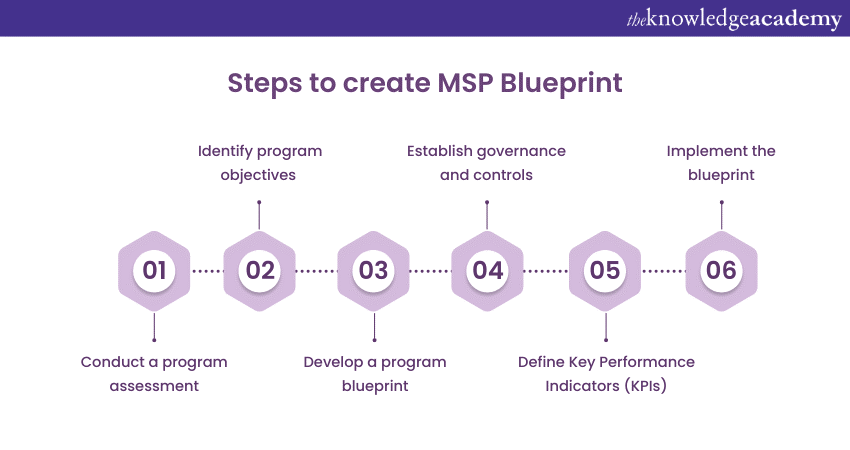We may not have the course you’re looking for. If you enquire or give us a call on +44 1344 203 999 and speak to our training experts, we may still be able to help with your training requirements.
Training Outcomes Within Your Budget!
We ensure quality, budget-alignment, and timely delivery by our expert instructors.

In the ever-evolving field of project management, organisations are constantly on the lookout for effective strategies to streamline their processes, maximise productivity, and achieve successful outcomes. One such strategy that has gained significant recognition is the implementation of an MSP Blueprint.
The Managing Successful Programmes (MSP) Blueprint serves as a roadmap that outlines the strategic objectives, structure, and governance of a program managed under the MSP methodology. It provides a holistic view of the program and acts as a guiding framework for effective project management.
This blog explains what an MSP Blueprint is and the steps to create one for the execution of a successful program. Read ahead to learn more!
Table of Contents
1) MSP Blueprint - A brief introduction
2) How do you create an MSP Blueprint?
a) Conduct a program assessment
b) Identify program objectives
c) Develop a program blueprint
d) Establish governance and controls
e) Define Key Performance Indicators (KPIs)
f) Implement the blueprint
3) Conclusion
MSP Blueprint - A brief introduction
An MSP Blueprint is a comprehensive framework that outlines the strategic objectives, structure, and governance of a program managed under the MSP methodology. It provides a structured approach that helps program managers and stakeholders navigate the complexities of managing multiple projects within a program. It also clarifies the program's vision, objectives, and desired outcomes, ensuring everyone involved is working towards a common goal.
Advance your program management skills by signing up for our MSP® Practitioner Course now!
Key components
There are certain components of the blueprint that you need to familiarise yourself with in order to understand it better. Its key components are as follows:
1) Vision statement: This component articulates the program's purpose and the desired outcomes it aims to achieve. It provides a clear direction and establishes a shared understanding among stakeholders.
2) Program organisation: The program organisation component defines the structure of the program, including roles, responsibilities, and reporting lines. It ensures that everyone involved understands their roles and collaborates effectively.
3) Governance framework: The blueprint establishes a governance framework that outlines decision-making processes, escalation procedures, and reporting mechanisms. This framework ensures accountability, transparency, and effective control throughout the program.
4) Benefits management: Benefits management focuses on identifying, quantifying, and delivering the expected benefits of the program. This component ensures that the program's initiatives align with the organisation's strategic objectives and deliver tangible value.
5) Risk and issue management: Risk and issue management are crucial for mitigating potential threats and addressing challenges that may arise during the program's lifecycle. The blueprint includes strategies and processes to identify, assess, and manage risks and issues effectively.
6) Communication plan: Clear and effective communication is vital for program success. The communication plan component of the blueprint outlines the channels, frequency, and stakeholders involved in program communications. It ensures that relevant information reaches the right people at the right time.
7) Resource management: Resource management allocates resources efficiently to support program activities. This component addresses resource availability, skills requirements, and capacity planning to ensure optimal resource utilisation.
Gain the basic knowledge and skills needed to successfully navigate program management with our MSP® Foundation Course today!
How do you create an MSP Blueprint?
Creating a blueprint for MSP involves a systematic and iterative process that ensures the effective design and implementation of the program. By following these step-by-step guidelines, you can develop a robust blueprint tailored to your organisation's needs:

1) Conduct a program assessment
The first step includes conducting a comprehensive assessment of the program. This involves analysing the current state, understanding the organisational context, and identifying key challenges and opportunities. Assess the program's alignment with strategic goals, evaluate the existing project portfolio, and gather insights from stakeholders.
2) Identify program objectives
Based on the assessment, clearly define the program objectives. These objectives should align with the organisation's strategic goals and address the identified challenges. Ensure the objectives are Specific, Measurable, Achievable, Relevant, and Time-bound (SMART). Engage stakeholders in the objective-setting process to foster a sense of ownership and alignment.
3) Develop a program blueprint
In this stage, you start by defining the program's vision, mission, and scope. Outline the key components, including the program organisation, governance framework, benefits management approach, risk and issue management strategies, communication plan, and resource management guidelines. Ensure each component is aligned with the program objectives and supports the overall program vision.
4) Establish governance and controls
Establish a robust governance framework that defines the program's decision-making processes, roles, and responsibilities. Clearly outline the reporting lines, escalation procedures, and mechanisms for program oversight. Implement effective controls to monitor progress, manage risks, and track performance against the program objectives.
5) Define Key Performance Indicators (KPIs)
Identify and define the Key Performance Indicators (KPIs) to measure the program's progress and success. These KPIs should align with the program objectives and reflect the desired outcomes. Ensure they are specific, measurable, attainable, relevant, and time-bound. Regularly monitor and report on these KPIs to gauge the program's performance and make informed decisions.
6) Implement the blueprint
Once the blueprint is developed, it's time to put it into action. Implement the program activities according to the defined structure and guidelines. Communicate the program objectives, roles, and responsibilities to the relevant stakeholders.
Monitor the progress, address any deviations, and make adjustments as necessary. Regularly review and update the blueprint to ensure its relevance and alignment with evolving organisational needs.

Conclusion
In conclusion, implementing a blueprint for MSP is a strategic approach that empowers organisations to manage complex programs effectively. We hope the contents of this blog have improved your knowledge of an MSP Blueprint and the steps to create one.
Drive successful program outcomes with our MSP® Training Courses today!







 Top Rated Course
Top Rated Course



 If you wish to make any changes to your course, please
If you wish to make any changes to your course, please


